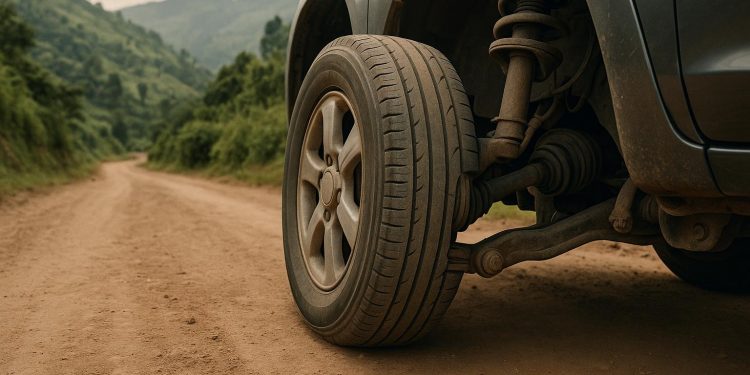Driving in Rwanda’s challenging terrain can wear out your vehicle’s suspension system faster than you might expect. From uneven tire wear to strange noises and poor steering response, there are clear warning signs that your suspension needs attention. Ignoring these issues can lead to unsafe driving conditions and costly repairs.
Here’s what you need to know:
- Uneven Tire Wear: Look for irregular patterns like cupping, which may indicate worn shocks or misalignment.
- Excessive Bouncing: If your car bounces too much after hitting a bump, your shocks or struts might be failing.
- Strange Noises: Clunking, squeaking, or knocking sounds on rough roads suggest damaged suspension parts.
- Steering Problems: Vibrations, pulling to one side, or sluggish steering could signal suspension or alignment issues.
- Visible Damage: Leaks near shock absorbers, cracked bushings, or uneven vehicle height are red flags.
Rwanda’s mix of paved roads and rugged tracks makes regular suspension inspections essential. Stay proactive by checking components every 12,000 miles, performing bounce tests, and consulting local mechanics for advice tailored to the terrain. Addressing small issues early ensures safer, smoother rides and saves money in the long run.
Car Suspension Problems and Symptoms: What You Need to Know
Warning Signs of Suspension Problems
Catching suspension issues early can save you from costly repairs and potential safety hazards. Rwanda’s rugged roads, with their mix of smooth highways and challenging terrain, can speed up wear on your vehicle’s suspension system. Keep an eye out for these key warning signs as you drive.
Uneven Tire Wear
If your tires show uneven wear, it’s often a clue that your suspension isn’t doing its job. Worn or damaged components can prevent the tires from maintaining proper contact with the road, causing irregular patterns. For instance, small scalloped dips (known as cupping) along the tire edges often point to worn shocks or struts allowing too much bouncing. Misalignment is another culprit and can shorten your tire’s lifespan by up to 25% if left unchecked.
Excessive Bouncing or Instability
Your suspension’s primary job is to absorb impacts and keep your car stable. If your vehicle bounces excessively after hitting bumps, potholes, or speed bumps, it’s a sign that your shocks or struts might be worn out. You can try a simple bounce test: press down on one corner of your car when it’s parked and let go. If the car keeps bouncing rather than settling quickly, it’s time for a closer look. Similarly, if your car sways too much when taking turns, it’s a strong indicator that your suspension needs attention.
Strange Noises
Driving over Rwanda’s uneven roads can sometimes bring out unusual noises caused by suspension issues. Squeaking, clunking, or knocking sounds when you hit bumps or potholes could mean worn bushings, damaged shock absorbers, or loose parts. Pay close attention to these noises, especially when turning or driving over rough terrain. If they grow louder or more frequent, it’s a good idea to have your suspension inspected.
Steering Problems
Good suspension ensures smooth and precise steering, which is especially important on Rwanda’s winding roads. If you notice your steering wheel vibrating at highway speeds or feel your car pulling to one side when driving straight, it could signal suspension or alignment problems. Sluggish or unresponsive steering is another warning sign, as it compromises your control over the vehicle – something you don’t want on challenging roads.
Visible Damage or Uneven Vehicle Height
Sometimes, suspension problems are visible. Walk around your car regularly and look for uneven vehicle height – if one corner of your car sits lower, it may point to a failed spring or shock absorber. Also, check for oil leaks around the shock absorbers and struts, as well as cracks or excessive wear on suspension bushings. Damaged bushings can lead to unwanted movement, affecting both handling and tire wear. If you notice the car bottoming out on small bumps, it’s a sign that the suspension can no longer absorb impacts effectively. This often results from worn springs or bushings, which we’ll explore further in the next sections.
What Causes Suspension Failure in Rwanda
Rwanda’s rugged terrain takes a heavy toll on vehicle suspensions. Knowing what leads to suspension failure can help you address issues early and avoid expensive repairs. Below, we break down the main causes of suspension problems unique to Rwanda’s driving conditions.
Worn Bushings and Shock Absorbers
Driving on Rwanda’s rough roads puts a lot of strain on suspension components like springs and shock absorbers. Each time your vehicle hits a pothole or navigates rocky terrain, it wears down the internal seals and cushioning materials in your bushings and shock absorbers.
"In Rwanda, where road conditions can vary widely, understanding how shock absorbers work and maintaining them properly can make a significant difference in your vehicle’s performance and your driving experience." – Inesm Auto24
When shocks and struts wear out, they lose their ability to control the vehicle’s ride, resulting in a bumpier, less comfortable drive. Worn bushings also fail to properly cushion metal components, leading to increased vibrations and added strain on other parts of the suspension system.
To stay ahead of these issues, it’s recommended to inspect shock absorbers every 12,500 miles. Given the challenging road conditions in Rwanda, more frequent checks can be even more beneficial.
Alignment Issues
Misalignment is another common culprit behind suspension problems in Rwanda. Deep ruts, rocks, and potholes can knock your wheels out of alignment, even after minor impacts.
When wheels are misaligned, suspension components are forced to work harder, which speeds up wear and tear. Misalignment also creates unsafe driving conditions, as it can lead to a loss of control.
"Prolonged driving with misaligned wheels will put undue stress on other suspension components, causing them to eventually fail, as well." – Gary Hardesty, ASE certified master technician and Kelley Blue Book’s in-house service and maintenance expert
While suspension parts are generally designed to last between 50,000 and 100,000 miles, Rwanda’s tough roads can significantly shorten this lifespan. Regular alignment checks are crucial to keeping your suspension system in good shape.
Chassis and Mount Stress
The constant stress on mounting points and subframes from potholes, uneven surfaces, and Rwanda’s hilly terrain can lead to serious problems over time. These forces create hairline cracks in the chassis and weaken mounting points. Additionally, the frequent transitions between paved and unpaved roads generate stress cycles that gradually wear down these critical connections.
To catch potential issues early, suspension parts should be inspected for damage and excessive wear at least once a year. In Rwanda’s demanding driving conditions, more frequent inspections of mounting points are a smart move to prevent small cracks from turning into major safety hazards.
sbb-itb-7bc66b5
How to Check and Fix Suspension Problems
Spotting suspension issues early can save you a lot of money and, more importantly, keep you safe on Rwanda’s demanding roads. Here’s how to identify and address potential problems before they escalate.
Regular Visual Inspections
Make it a habit to inspect your vehicle every few weeks. Start by looking for uneven tire wear – check the tread depth across all tires to catch unusual patterns early.
Next, examine the area around your shock absorbers and struts for oil leaks. If you spot fresh oil stains or wet spots, it could mean the internal seals are failing. Also, inspect the rubber bushings that connect suspension parts to the vehicle’s frame for any visible damage.
Check if your vehicle sits evenly when parked on level ground. Uneven positioning can be a sign of suspension issues, especially for cars frequently navigating Rwanda’s steep roads.
Perform a bounce test by pushing down firmly on each corner of the vehicle and releasing. The car should bounce once and settle. If it bounces multiple times or feels unstable, your shocks or struts might need replacing.
Finally, confirm your findings with a test drive to pinpoint any lingering issues.
Road Testing for Suspension Issues
After visually inspecting your vehicle, take it for a test drive to uncover problems that aren’t immediately visible. Choose a route that includes a variety of road conditions, such as smooth pavement, potholes, hills, and sharp turns – conditions you’re likely to encounter in Rwanda.
"When you don’t perform a test drive, you are neglecting your most powerful inspection tool: the perspective of an expert." – Andrew Markel, Director of Content, Brake & Front End magazine
Before hitting the road, make sure your vehicle is safe to drive. During the test, pay close attention to how your car responds to different conditions:
- Listen for clunking, squeaking, or rattling sounds over bumps, which could point to worn bushings or damaged shocks.
- Watch how the car behaves after hitting a bump. Excessive bouncing may indicate worn suspension components.
- Test stability during turns and braking. If the car leans too much while cornering or dives sharply when braking, the suspension might not be effectively managing body movement.
- Look out for pulling to one side during braking, which could signal alignment issues.
- Assess steering responsiveness. Increased effort or wandering is a red flag that needs immediate attention.
"A good test driver will be able to observe conditions or problems with the vehicle that may have developed so slowly that the owner is unaware of them, such as degraded shocks and struts." – Andrew Markel, Director of Content, Brake & Front End magazine
When to See a Mechanic
Some suspension problems are too complex or dangerous to handle on your own and require professional help. For instance, severe steering issues like a jerking wheel or loss of control need immediate attention.
If you notice visible structural damage, such as cracked springs or bent control arms, don’t attempt to drive the vehicle. These issues pose serious safety risks and should be addressed by a professional as soon as possible.
When choosing a mechanic, start by asking friends, family, or coworkers for recommendations. Look for certifications like ASE (Automotive Service Excellence) if available. A trustworthy mechanic will take the time to ask detailed questions about your car’s symptoms, explain the problem in simple terms, and provide a written estimate before starting repairs.
Be cautious of mechanics who pressure you into immediate repairs or refuse to provide written estimates. If you’re trying out a new shop, consider starting with minor services, like an oil change, before trusting them with major suspension repairs. This approach can help you build a relationship with a mechanic you can depend on for regular maintenance in Rwanda’s challenging driving conditions.
Keeping Your Suspension Working Well in Rwanda
Maintaining your suspension system in Rwanda’s rugged and diverse terrain takes a proactive approach. By focusing on regular upkeep and considering upgrades suited to the local roads, you can keep your vehicle performing at its best.
Regular Maintenance Schedules
Rwanda’s tough road conditions call for a disciplined maintenance routine. It’s recommended to inspect your suspension system every 12,000 to 12,500 miles. This routine should include checks on tires, brakes, oil levels, suspension components, and the fuel system.
When inspecting your suspension, pay close attention to springs, shock absorbers, and struts. Look for signs like oil leaks near the shocks, worn-out rubber bushings, or loose mounting points. Staying on top of these checks can save you from costly repairs and ensure your vehicle handles Rwanda’s roads smoothly.
Don’t forget to clean the undercarriage frequently, especially after driving through muddy or dusty areas. This simple step can help prevent early wear on your suspension components.
Stronger Suspension Parts
If you often drive on rough terrain, upgrading to heavy-duty suspension components can make a noticeable difference. Heavy-duty springs and shocks are built to handle the challenges of uneven roads. For those navigating particularly tough rural areas or needing extra ground clearance, body suspension lift kits are worth considering. These kits replace the entire suspension system, offering improved articulation and higher lift.
Enhanced shock absorbers can also improve both ride quality and handling, especially for off-road driving. For example, the Nimbus oleo-pneumatic system is a top-tier upgrade. Mahmood Asim Al Raisi, an Ineos Grenadier owner, shared his satisfaction after making the switch:
"It feels like a Range Rover and was the best investment ever."
This system, priced at $4,980 USD, shows how investing in quality suspension upgrades can elevate both comfort and performance.
Tire Care and Maintenance
Your tires play a critical role in protecting your suspension system from Rwanda’s varied road surfaces. Always maintain the manufacturer-recommended tire pressure, rotate your tires regularly to ensure even wear, and check alignment every 6,000 to 10,000 miles. Under-inflated tires can strain your suspension, while over-inflation reduces the tire’s ability to absorb shocks.
One transport company reported a 2% improvement in fuel economy after adopting a strict alignment schedule. Their fleet manager also noted that routine alignments extended tire life to over 100,000 miles, resulting in significant savings. For advice tailored to Rwanda’s unique road conditions, consult local experts who understand the terrain.
Getting Help from Local Experts
Rwanda’s automotive scene has grown, with local mechanics gaining expertise in the country’s specific driving challenges. Partnering with skilled professionals can make a big difference in keeping your suspension system in top shape.
When choosing a mechanic, prioritize those familiar with Rwanda’s terrain. Platforms like AutoMag.RW connect drivers with trusted local experts who specialize in suspension systems and understand the demands of the region’s roads. These professionals can offer personalized advice on maintenance and recommend upgrades based on your driving habits.
Building a relationship with a reliable service center ensures that small suspension issues are addressed early, preventing them from turning into costly problems.
Conclusion
Rwanda’s rugged terrain can put your vehicle’s suspension to the test. Spotting issues early is crucial for both safety and performance. Be on the lookout for warning signs like poor steering response, excessive bouncing, strange noises, uneven tire wear, or fluid leaks. If you notice any of these, don’t wait – address them immediately.
Given the challenges of potholes and uneven roads, staying proactive with your vehicle’s care is a must. These conditions can speed up suspension wear, so regular maintenance is vital. For instance, make it a habit to inspect your shock absorbers as outlined in your manufacturer’s guidelines.
Routine inspections and timely repairs are the backbone of keeping your suspension in good shape. Not only does this extend the life of your tires and provide a smoother ride, but it also ensures precise wheel alignment, which is critical for safe driving on Rwanda’s unpredictable roadways.
In addition to regular inspections, take simple steps like checking tire pressure, examining suspension components for visible damage or leaks, and staying alert to changes in your vehicle’s handling. Ignoring minor issues like slight bouncing or subtle steering problems can lead to costly repairs – or worse, unsafe driving conditions.
Finally, tapping into the expertise of local mechanics who understand Rwanda’s roads can make a big difference. They can offer advice tailored to the unique demands of the terrain, helping you make timely repairs or upgrades. Suspension maintenance isn’t just about comfort – it’s about protecting your safety and preserving your vehicle in a challenging driving environment. Addressing problems early ensures a safer, smoother driving experience across Rwanda’s diverse landscapes.
FAQs
What are the signs that my vehicle’s suspension is struggling with Rwanda’s challenging road conditions?
If Rwanda’s rugged roads are taking a toll on your vehicle’s suspension, keep an eye out for these warning signs:
- Uneven tire wear: This could point to alignment problems or suspension issues.
- Excessive bouncing: If your car keeps bouncing after hitting bumps or potholes, it might mean your shocks or struts are worn out.
- Unusual noises: Clunking or squeaking sounds when driving over rough terrain can signal trouble with suspension components.
- Visible damage or leaks: Check for any cracks, damage, or fluid leaks in parts like shocks or struts.
The potholes, gravel, and uneven surfaces common on Rwanda’s roads can put extra stress on your suspension system. Regular check-ups and timely repairs can help ensure a smoother ride and keep your vehicle in good shape for longer.
How can I protect my vehicle’s suspension system while driving on Rwanda’s rugged roads?
To keep your suspension system in good condition while tackling Rwanda’s rugged roads, here are some practical tips to follow:
- Inspect regularly: Look out for signs like uneven tire wear or excessive bouncing. Addressing these issues early can save you from bigger problems down the line.
- Avoid overloading: Stick to the weight limits recommended for your vehicle. Overloading puts unnecessary strain on the suspension.
- Drive cautiously: Take it slow on rough or unpaved roads, and steer clear of potholes whenever you can.
- Maintain tire pressure: Properly inflated tires help distribute weight evenly and reduce stress on the suspension system.
- Replace worn parts: If components like shocks or struts are showing wear, replace them as soon as possible to avoid further damage.
By staying on top of maintenance and adjusting how you drive to match the terrain, you can keep your suspension system running smoothly and enjoy a safer, more comfortable ride.
How often should I check my vehicle’s suspension system when driving on Rwanda’s rugged roads?
Rwanda’s hilly and uneven roads can take a toll on your vehicle’s suspension system, making it crucial to have it checked at least once a year. But don’t wait for your annual inspection if you notice warning signs like strange noises, uneven tire wear, or trouble steering – these are clear signals to get it looked at sooner.
Routine suspension inspections aren’t just about safety; they also help maintain your vehicle’s performance. By staying ahead of potential issues, you can avoid expensive repairs and enjoy a smoother, more reliable ride, even on rugged terrain.
Related posts
- Ultimate Guide to Off-Road Driving in Rwanda
- Vehicle Inspection Checklist for Rwandan Drivers
- Common Car Problems in Rwanda (And How to Prevent Them)





